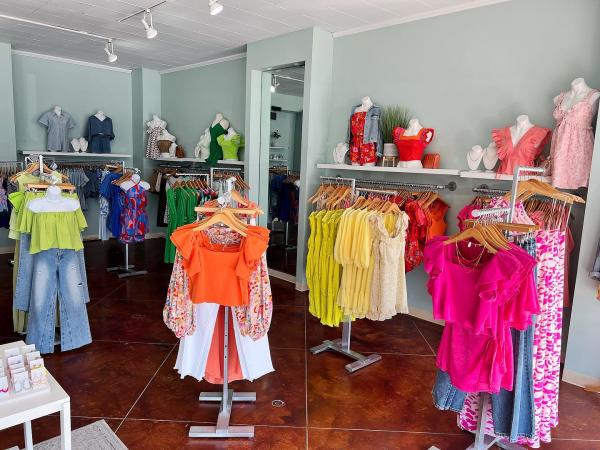Checking Out the Advancement and Impact of Garments on Modern Style Trends
The evolution of clothes has actually significantly influenced contemporary style fads, merging historical precedents with sophisticated innovations. Famous numbers like Coco Chanel and Yves Saint Laurent changed the fashion business by introducing ideas that focus on convenience and accessibility, which continue to resonate today. Technological strides in areas such as 3D printing and smart textiles are redefining design possibilities and consumer experiences (boutique fashion). Additionally, the growing emphasis on inclusivity and sustainability is reshaping industry standards. As we think about these diverse influences, one should doubt exactly how these aspects collectively redefine fashion's role in reflecting and shaping modern culture.
Historic Fashion Influencers
In the tapestry of style history, particular figures have actually left an indelible mark, forming the trends and styles that specify entire periods. Coco Chanel, an innovative developer, redefined women's style by introducing comfy, elegant garments that left from restrictive bodices.
Elsa Schiaparelli is another essential number, renowned for her avant-garde styles that incorporated surrealist art, working together with Salvador Dalí to develop whimsical pieces that tested conventional looks. Her innovative use shade and bold patterns reverberates in modern style. Yves Saint Laurent, meanwhile, equalized haute couture with prêt-à-porter collections, bringing runway styles to the masses and setting a criterion for modern-day ready-to-wear lines.
These visionaries, to name a few, not just transformed style in their times but likewise established sustaining trends that resonate in today's apparel industry, giving a foundation upon which contemporary designers proceed to construct and introduce. Their legacies highlight the value of imagination and bold in style's ever-evolving story.
Technological Innovations in vogue
Among the vibrant landscape of the garment industry, technical improvements stand at the leading edge of innovation, reshaping how designers create and consumers engage with fashion. The integration of 3D printing has revolutionized design processes, enabling developers to experiment with complex frameworks and lasting products that were previously unthinkable. This innovation helps with rapid prototyping, reducing waste and expediting manufacturing times.

Smart fabrics, installing innovation right into fabrics, are additionally transforming the market. Technologies like temperature-regulating and self-cleaning textiles provide boosted functionality and comfort. Wearable modern technology, incorporating functions like health and fitness tracking and communication, includes a new dimension to style, merging aesthetic appeals with usefulness.
Social Shifts and Style
As technological developments proceed to improve the style sector, social changes are just as significant, redefining style and consumer preferences. In recent years, the rise of social media platforms has accelerated the dissemination of global fashion trends, allowing diverse cultural impacts to exist side-by-side and merge. This electronic interconnectivity has actually promoted the quick exchange of ideas, resulting in a more eclectic and inclusive analysis of style that reflects the multifaceted nature of modern culture.
Social understanding and recognition have prompted developers to attract motivation from a wider spectrum of ethnic and historical contexts, incorporating conventional motifs with modern appearances. This blend has resulted in style that reverberates with a larger audience, advertising a sense of identity and belonging throughout different sites demographics. Additionally, the raising demand for personalization has actually driven brand names to use personalized choices, enabling consumers to reveal individuality while mirroring their social heritage.
Additionally, moving societal values have affected style, with inclusivity and diversity becoming main motifs. The sector has actually begun to embrace models and influencers of numerous type of body, ethnic cultures, and gender identities, tough traditional appeal criteria. This improvement emphasizes the power of social shifts fit the future of fashion, as design comes to be a much more genuine expression of personal and collective identification.
Sustainability and Modern Style
While the style industry continues to develop, the critical for sustainability has actually come to be significantly urgent, affecting modern-day design practices. The rise of slow-moving style, which emphasizes quality over quantity, encourages customers to invest in ageless pieces instead than short-term trends.
In addition, contemporary layout is image source defined by its advancement in reducing waste and promoting circularity. Techniques such as zero-waste pattern cutting and 3D knitting are acquiring traction, enabling designers to produce garments with marginal material wastefulness. In addition, brand names are taking on transparent supply chains, making sure accountability and promoting consumer depend on. This approach not just minimizes ecological impact however also boosts the social responsibility of style houses.

Future Trends in vogue

Sustainability will remain to be a driving pressure in shaping future style patterns. The sector is progressively taking on green products and moral production methods, replying to a growing consumer demand for responsible methods. Innovations such as bio-fabricated products and closed-loop recycling systems are set to redefine just how garments is produced and taken in, reducing ecological impact while preserving design and high quality.
Social shifts, consisting of the rise of inclusivity and variety, will certainly likewise play a crucial function. As culture becomes a lot more aware of social problems, style is expected to end up being a system for expression and change. Designers will likely concentrate on creating collections that show a more comprehensive variety of experiences and identifications, championing depiction and access.
Conclusion
The development of clothing substantially influences modern style trends, where historical influences combine with modern designs. Secret numbers like Coco Chanel and Yves Saint Laurent have redefined style, while technological technologies such as 3D printing and clever fabrics expand innovative possibilities. Social changes in the direction of inclusivity and sustainability compel brands to embrace moral techniques and welcome variety. This continuous advancement emphasizes style's role as a mirror to Full Report societal values and technological development, suggesting a future rich with advancement and inclusivity.
The development of clothes has significantly affected modern-day fashion trends, merging historic criteria with innovative advancements.In the middle of the dynamic landscape of the style sector, technological developments stand at the forefront of technology, improving exactly how developers develop and consumers engage with style.While the fashion sector proceeds to develop, the crucial for sustainability has become significantly urgent, affecting contemporary design techniques. As sustainability ends up being embedded in contemporary design, it leads the method for a more conscious and liable fashion sector.
The development of clothing substantially impacts modern-day fashion patterns, where historical impacts merge with contemporary layouts.